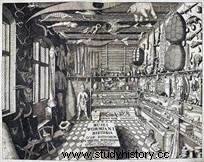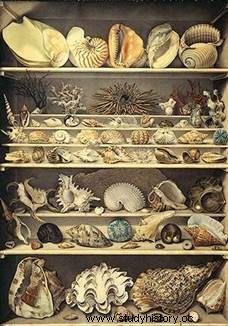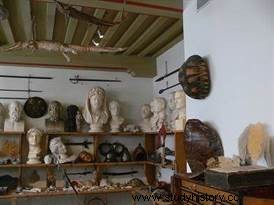 The cabinets of curiosities are places bringing together collections of various objects, from nature or created by the hand of man, and characterized by their rarity, their strangeness and/or their exoticism. Curious, curiosities and cabinets of curiosities are the ancestors of our collectors, collections and museums. Indeed, under the Ancien Régime, the “curious” sought out and stored “curiosities” in their “cabinet or gallery”. While nowadays we manage to collect almost everything and nothing, the curious of Old France were attached to objects created by Man and by God.
The cabinets of curiosities are places bringing together collections of various objects, from nature or created by the hand of man, and characterized by their rarity, their strangeness and/or their exoticism. Curious, curiosities and cabinets of curiosities are the ancestors of our collectors, collections and museums. Indeed, under the Ancien Régime, the “curious” sought out and stored “curiosities” in their “cabinet or gallery”. While nowadays we manage to collect almost everything and nothing, the curious of Old France were attached to objects created by Man and by God.
At the origin of cabinets of curiosities
The curious are at the start of the Princes and Great Lords because they have more knowledge, knowledge and financial means. François I was very curious about natural objects, while Charles IX and Henri III were stripped of their curiosities. It is necessary to wait for Richelieu who will take up the torch by building up an enormous collection and Louis XIV, a great lover of medals. Then the nobles, the ecclesiastics, the people of Robe, the health professions are interested in it, but it is always about an elite. These curious people procured antique statues, beautiful old books and manuscripts as well as medals because “owning a medallion becomes a mark of distinction” during the Grand Siècle.
 In the 1650s, there were about thirty curious people in Paris; around 1700/1720, there were 150 and the golden age was between 1750/1790, bringing together around 500 people, the nobles representing 10% of the curious in the 18th century. According to the inventories, Paris and the South are the two large provinces where we find the most. Alongside the elite (Great Lords, ecclesiastics), financiers and merchants are curious, because for the individual it is very difficult financially to collect precious objects.
In the 1650s, there were about thirty curious people in Paris; around 1700/1720, there were 150 and the golden age was between 1750/1790, bringing together around 500 people, the nobles representing 10% of the curious in the 18th century. According to the inventories, Paris and the South are the two large provinces where we find the most. Alongside the elite (Great Lords, ecclesiastics), financiers and merchants are curious, because for the individual it is very difficult financially to collect precious objects.
Over time, the curious specialize in a particular field, grouping together series of objects of the same theme, as doctors or apothecaries did. The amateur of this particular theme then takes the name of "collector" and "collecting" was born in 1828.
Curiosity objects
Curiosity appears between the Renaissance and the Classical Age, having the characteristic of rarity, exoticism and oddity. The objects collected were usually those that were not or no longer used, and became objects of decoration and contemplation. They were also objects of communication because the great lords showed their fortune, their power and later their knowledge.
The curiosities always had a link with Antiquity and the Middle Ages, the treasures of Princes and the religious domain. From the 16th century, thanks to the Great Discoveries and increasing knowledge, the objects became more diverse.
 These objects are classified into two themes:works created by men and works created by God. God's creations are mainly precious stones, fossils, unicorn horns, corals, rare flowers. In the works of men, there are paintings, sculptures, goldsmith's objects, physical instruments, weapons, antiquities, medals. But all these exotic objects were an essential ornament in cabinets of curiosities.
These objects are classified into two themes:works created by men and works created by God. God's creations are mainly precious stones, fossils, unicorn horns, corals, rare flowers. In the works of men, there are paintings, sculptures, goldsmith's objects, physical instruments, weapons, antiquities, medals. But all these exotic objects were an essential ornament in cabinets of curiosities.
Medals have a place of choice. It is a fascinating object, mixing art and history. They are diverse and can be ancient medals, modern medals, imperial medals.
Antiques, on the other hand, occupy a prominent place, almost revered. They are curiosities worthy of interest and include engraved stones, vases, sarcophagi, statues and statuettes, but above all Egyptian. The great will seek out portraits of illustrious men to hang them in their gallery, so much so that this fashion spread to France at the time of Henri IV who had the Louvre decorated.
The objects were very often numerous and very diverse, as with Hans Sloane, a colonial doctor who gathered his curiosities in eleven rooms containing, among other things, 5,440 insects, 660 sea urchins, 520 snakes in alcohol, 7000 fruits, 23,000 coins. Between 1680 and 1720, medals gave way to shells, Italian painting to painting from the North and the curious went looking for useful objects. Great collectors will get earthenware.
In the midst of the Enlightenment, the curious will become attached to science. The Beautiful gives way to the True. The marvelous and the exotic are replaced by objects of which men of science speak. Many cabinets of scientific curiosity are born (physics, chemistry) which will become our laboratories. And the objects will be classified into categories, series and chronologically. When their owners died, the collections were often sold through catalogs which appeared around 1700 in Paris and only around 1745 in Lille; some other owners bequeath their collections to educational or public interest centers in order to make them an object of memory and culture.
Cabinets of curiosities and galleries
The curiosities are installed in a specific place the "cabinet" and classified in alphabetical order, then by families according to size or shape. Cabinets of curiosities are special rooms, very often located next to the bedroom. This place then becomes a place of study, wonder and meditation. Everything is organised, tidy and classified, in drawers, on shelves, large objects on the floor or on the ceiling, rare plants in a botanical garden, but the whole thing must be pleasant and pleasant to see.
 Depending on the category of the curious and the specificity of the objects, the places differ:paintings and sculptures are exhibited in the gallery. Since Antiquity, the gallery had museum value. Under the Ancien Régime, it was the room where a collection was brought together, "the place that we attach the most to making magnificent and that we embellish with the riches of the fine arts". This room practically only existed in the royal residences or in the homes of the Great, Henri IV himself had started by creating the "Little Gallery" at the Louvre. Over time, these royal collections will be transformed into museums.
Depending on the category of the curious and the specificity of the objects, the places differ:paintings and sculptures are exhibited in the gallery. Since Antiquity, the gallery had museum value. Under the Ancien Régime, it was the room where a collection was brought together, "the place that we attach the most to making magnificent and that we embellish with the riches of the fine arts". This room practically only existed in the royal residences or in the homes of the Great, Henri IV himself had started by creating the "Little Gallery" at the Louvre. Over time, these royal collections will be transformed into museums.
To go further
- Cabinets of curiosities. The Passion for Collecting, by Christine Davenne. La Martiniere, 2011.
- Cabinets of curiosities &unusual collections, by Capucine Lemaître. Editions Ouest-France, 2019.
